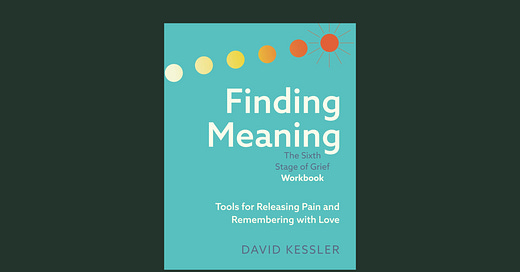Sometimes, I throw off people with my honesty. They'll ask something like, "Do you still miss your mom?" or "Is your grief as bad as it was when you first lost her?" and my answer to both is usually, "Yeah."
Because grief isn't linear and its weight doesn't change. I still miss my mom because I'm her daughter and can't pick up the phone to call her. My grief is as heavy as it first was because it didn't jump on the treadmill, I just learned to live my life going to the metaphorical grief gym. I work hard (in therapy, in life) to remember I'm not 10 years old anymore and can bench more than I could back then.
I'm different, stronger, and aware of my feelings. I give myself more permission every day to simply practice feeling grief in all its forms. It isn't easy for me (or for anyone grieving), but there are tools you can turn to that help.
Grief expert David Kessler is a good friend and the author of the new workbook, Finding Meaning: the Sixth Stage of Grief Workbook: Tools for Releasing Pain and Remembering with Love. I asked him to answer a few questions about his new workbook (which accompanies his book with the same title).
David is also the author of On Grief and Grieving: Finding the Meaning of Grief Through the Five Stages of Loss with Elisabeth Kübler-Ross and the mind behind one of my favorite quotes, "Emotions need motion." In perfect fashion, he dropped another bit of wisdom below: "Sometimes, we revolve instead of evolving." Read below to see how to do more of the latter than the former. The interview was edited for length and clarity.
VN: Hi David, so excited to chat about your new workbook — Finding Meaning: the Sixth Stage of Grief Workbook: Tools for Releasing Pain and Remembering with Love. What inspired you to put together this workbook?
DK: I created this workbook based on the work with people in my grief groups. So often, I work with people who have experienced grief and trauma, and they have such judgment on their timeline. They feel like grief should be a linear process or their friends and family say that they should be over it.
We can use tools and exercises when we are in grief to better understand ourselves and our grieving process. People experience guilt, and they ruminate over the same ideas again and again. Sometimes, we revolve instead of evolving. I’ve included exercises to help break the chains of guilt.
I wish I could sit across the table from everyone who is in grief and trauma and in pain, but I can’t. So, I created this self-guided workbook to do this important work to release pain and remember with more love.
VN: What do you hope readers will take away?
DK: Grief must be witnessed. Sitting with our grief and feeling our feelings makes a difference. I often talk about the way that Buffalos deal with an approaching storm. They run towards the storm and continue through it instead of avoiding it.
It’s natural to want to avoid our pain. I hope that people will use this workbook as a gentle and compassionate guide to give their grief a voice. I am so honored to be part of their journey, and I hope the workbook can be a GPS to help navigate the rocky terrain of grief.
VN: Do you think this workbook is helpful for anyone, no matter how long they've been on their grief journey?
DK: This workbook will be there for you whenever you are ready to attend to your grief. There’s no timeline in grief. I always say that grief is a no-judgement zone. I wrote and designed this workbook for anyone, no matter where they are in their grief journey. It can also be used for grief that is not around the death of a loved one, including breakups, divorce, and estrangement. Grief is the death of something. It can be the death of a relationship, the death of our feelings of safety, or the death of a dream.
Whether your loss is new or if it happened many, many years ago, attending to your grief can be life-changing. Griefwork (whenever you do it) is the ultimate self-care.
VN: Why do you think exercises and journaling prompts are so helpful in the grief process?
DK: While grief is universal, it’s also highly personal. No one had your loss. While many people have had their mothers die, no one had a mother like yours with your specific relationship. Not even your siblings.
In the workbook, I guide readers (who become co-authors) through witnessing and understanding your specific grief process. It’s a highly individualized approach. So often, we read a book, and it has a lot of helpful information and is filled with research and great ideas - but do we always take the time to apply it?
By creating a workbook, I am leading you on a journey of self-discovery and healing. The exercises and activities become highly personalized because the pause to reflect and do the work is built into the process.
VN: I call this section — Book Pairings (like wine and cheese, but all about books). What other books does your workbook pair well with?
DK: What a great question! Here’s what I have been reading lately:
It’s Not You - Ramani Durvasula - This is an eye-opening book about identifying and healing from narcissistic people
To Be Loved - Frank Anderson - Frank Anderson shares his journey of truth, trauma and transformation
Nothing to Fear - Julie McFadden, RN - Death and dying is such a taboo topic in our culture. Hospice Nurse Julie shares her insight and expertise on end-of-life and hospice.





